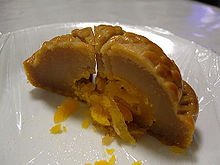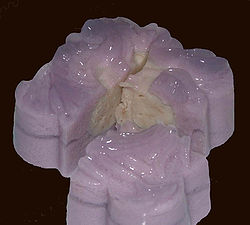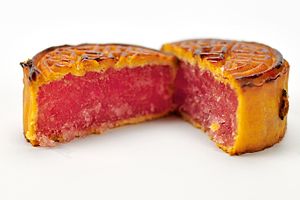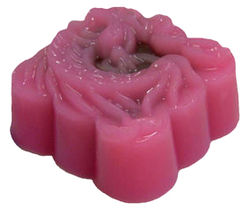- Mooncake
-
Mooncake 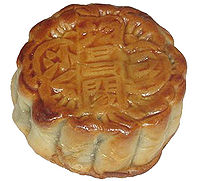
Traditional Chinese 月餅 Simplified Chinese 月饼 Hanyu Pinyin yuèbĭng Literal meaning Moon cake/biscuit Transcriptions Gan - Romanization Ngiet7 biang3 Hakka - Romanization Ngat biang Mandarin - Hanyu Pinyin yuèbĭng - Wade–Giles yüeh-ping - IPA [ɥɛ̂pìŋ] Min - Hokkien POJ go̍eh-piáⁿ Wu - Romanization [ɲyɪʔ piɲ] Cantonese (Yue) - Jyutping jyut6 beng2 Mooncake (simplified Chinese: 月饼; traditional Chinese: 月餅; pinyin: yuè bĭng) is a Chinese bakery product traditionally eaten during the Mid-Autumn Festival / Zhongqiu Festival. The festival is for lunar worship and moon watching; mooncakes are regarded as an indispensable delicacy on this occasion. Mooncakes are offered between friends or on family gatherings while celebrating the festival. The Mid-Autumn Festival is one of the four most important Chinese festivals.
Typical mooncakes are round or rectangular pastries, measuring about 10 cm in diameter and 4–5 cm thick. A rich thick filling usually made from red bean or lotus seed paste is surrounded by a relatively thin (2–3 mm) crust and may contain yolks from salted duck eggs. Mooncakes are usually eaten in small wedges accompanied by Chinese tea. Today, it is customary for businessmen and families to present them to their clients or relatives as presents,[1] helping to fuel a demand for high-end mooncake styles. Mooncake energy content can vary with the filling and size; the average moon cake carries 800 to 1200 kcal, mainly from fats and sugar.
Contents
General description
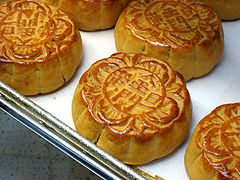 Mooncakes with Chinese characters “金門旦黃 (Kinmen danhuang)” which literally means :(using) egg yolks produced in Kinmen, R.O.C.
Mooncakes with Chinese characters “金門旦黃 (Kinmen danhuang)” which literally means :(using) egg yolks produced in Kinmen, R.O.C.
Most mooncakes consist of a thin, tender skin enveloping a sweet, dense filling, and may contain one or more whole salted egg yolks in its center to symbolise the full moon. Very rarely, mooncakes are also served steamed or fried.
Traditional mooncakes have an imprint on top consisting of the Chinese characters for "longevity" or "harmony", as well as the name of the bakery and the filling inside. Imprints of the moon, the Chang'e woman on the moon, flowers, vines, or a rabbit (symbol of the moon) may surround the characters for additional decoration.
Mooncakes are considered a delicacy; production is labor-intensive and few people make them at home. Hence, most prefer to buy them from commercial outlets, which may range from smaller individual bakery shops to high-end restaurants. The price of mooncakes usually ranges from US$10 to US$50 for a box of four, although cheaper and more expensive mooncakes can also be found.
History
Mid-Autumn Festival
The festival is intricately linked to the legends of Chang E, the mythical Moon Goddess of Immortality. According to "Li-Ji", an ancient Chinese book recording customs and ceremonies, the Chinese Emperor should offer sacrifices to the sun in spring and the moon in autumn. The 15th day of the 8th lunar month is the day called "Mid-Autumn". The night on the 15th of the 8th lunar month is also called "Night of the Moon". Under the Song Dynasty (420), the day was officially declared for Mid-Autumn Festival.
Because of its central role in the Mid-Autumn festival, mooncakes remained popular even in recent years. For many, they form a central part of the Mid-Autumn festival experience such that it is now commonly known as 'Mooncake Festival'.
Ming revolution
There is a folk tale about the overthrow of Mongol rule facilitated by messages smuggled in moon cakes.
Mooncakes were used as a medium by the Ming revolutionaries in their espionage effort to secretly distribute letters to overthrow the Mongolian rulers of China in the Yuan dynasty. The idea is said to have been conceived by Zhu Yuanzhang (朱元璋) and his advisor Liu Bowen (劉伯溫), who circulated a rumor that a deadly plague was spreading, and the only way to prevent it was to eat special mooncakes. This prompted the quick distribution of mooncakes, which were used to hide a secret message coordinating the Han Chinese revolt on the 15th day of the eighth lunar month.[2]
Another method of hiding the message was printed in the surface of mooncakes as a simple puzzle or mosaic. To read the encrypted message, each of the four mooncakes packaged together must be cut into four parts each. The 16 pieces of mooncake, must then be pieced together in such a fashion that the secret messages can be read. The pieces of mooncake are then eaten to destroy the message.[3][4]
Traditional styles
Fillings
Many types of fillings can be found in traditional mooncakes according to the region's culture:
- Lotus seed paste (蓮蓉, lían róng): Considered by some[who?] to be the original and most luxurious mooncake filling, lotus paste filling is found in all types of mooncakes. Due to the high price of lotus paste, white kidney bean paste is sometimes used as a filler.
- Sweet bean paste (豆沙, dòu shā): A number of pastes are common fillings found in Chinese desserts. Although red bean paste, made from azuki beans, is the most common worldwide, there are regional and original preferences for bean paste made from mung beans, as well as black beans, known throughout history.
- Jujube paste (棗泥, zǎo ní): A sweet paste is made from the ripe fruits of the jujube (date) plant. The paste is dark red in color, a little fruity/smoky in flavor, and slightly sour in taste. Depending on the quality of the paste, jujube paste may be confused with red bean paste, which is sometimes used as a filler.
- Five kernel (五仁, wǔ rén): A filling consisting of 5 types of nuts and seeds, coarsely chopped, is held together with maltose syrup. Recipes differ from region to region, but commonly used nuts and seeds include: walnuts, pumpkin seeds, watermelon seeds, peanuts, sesame seeds, or almonds. In addition, the mixture will usually contain candied winter melon, jinhua ham, or pieces of rock sugar as additional flavoring.
Crusts
Traditional mooncakes vary widely depending on the region where they are is produced. Most regions produce them with many types of fillings, but with only one type of crust. Although vegetarian mooncakes may use vegetable oil, many mooncakes use lard in their recipes for a better taste. Three types of mooncake crust are used in Chinese cuisine:
- Chewy: This crust has a reddish-brown tone and glossy sheen. It is the most common type of crust used on Cantonese-style mooncakes. It is also the most commonly seen type of mooncake in North America and many western countries. Chewy mooncake crusts are made using a combination of thick sugar syrup, lye water (枧水 sodium hydroxide NaOH) or sodium carbonate (碱面 Na2CO3), flour, and oil, thus giving this crust its rich taste and a chewy yet tender texture. Chewiness can be increased further by adding maltose syrup to the mixture.
- Flaky: Flaky crusts are most indicative of Suzhou- and Taiwan-style mooncakes. The dough is made by rolling together alternating layers of oily dough and flour that has been stir-fried in oil. This crust has a texture similar to puff pastry.
- Tender: Mooncakes from certain provinces of China[which?] are often made to be tender rather than flaky or chewy. The texture of this type of mooncake crust is similar to the shortcrust pastry used in Western pie crusts or tart shells. Tender crusts are made mainly of a homogenous mix of sugar, oil, flour, and water. This type of crust is also commonly used in other type of Chinese pastries, such as the egg tart.
Regional variations in mainland China and Taiwan
There are many regional variants of the mooncake. Types of traditional mooncake include:
- Beijing-style mooncake: This style has two variations. One, called di qiang, was influenced by the Suzhou-style mooncake. It has a light, foamy dough as opposed to a flaky one. The other variation, called "fan mao, has a flaky, white dough. The two most popular fillings are the mountain hawthorn and wisteria blossom flavors. The Beijing-style mooncake is often meticulously decorated.
- Cantonese-style mooncake: Originating from Guangdong province, the Cantonese style mooncake has multiple variations. The ingredients used for the fillings are various: lotus seed paste, melon seed paste, nuts, ham, chicken, duck, roast pork, mushrooms, egg yolks, etc. More elaborate versions contain four egg yolks, representing the four phases of the moon. Recent contemporary forms (albeit nontraditional) sold in Hong Kong are even made from chocolate, ice-cream or jelly.[5]
- Chaoshan (Teochew)-style mooncake: This is another flaky crust variety, but is larger in size than the Suzhou variety. It is close in diameter to the Cantonese style, but thinner. A variety of fillings are used, but the aroma of lard after roasting is emphasised.
- Ningbo-style mooncake: This style is also inspired by the Suzhou-style. It is prevalent in Zhejiang province, and has a compact covering. The fillings are either seaweed or ham; it is also known for its spicy and salty flavor.
- Suzhou-style mooncake:: This style began more than a thousand years ago, and is known for its layers of flaky dough and generous allotment of sugar and lard. Within this regional type, there are more than a dozen variations. It is also smaller than most other regional varieties. Suzhou-style mooncakes feature both sweet and savory types, the latter served hot and usually filled with pork mince. Filling made from roasted black sesame (椒鹽, jiāoyán') are common in flaky Suzhou-style mooncakes.
- Yunnan-style mooncake: Also known as t'o to the residents, its distinctive feature is the combination of various flours for the dough, and includes rice flour, wheat flour, and buckwheat flour. Most of the variations are sweet.
- Taiwanese-style mooncake: The most traditional mooncake found within Taiwan is filled with sweetened red bean paste, sometimes with mochi in the center. The most common traditional mooncakes coming from Taiwan are filled mung bean(lu dou) or taro paste, generally with a salted duck egg yolk in the mung bean mooncakes, and either salted duck egg or a savory treat in the taro mooncakes.[6] Modern, more trendy Taiwanese moon cakes are wide in variety that include low fat, lard free and ice cream versions. Popular modern flavors include green tea, chocolate, and tiramisu.
Contemporary styles
Over time, both the crusts and the composition of the fillings of mooncakes have diversified, in particular due to a commercial need to drive up sales in the face of intense competition between producers and from other food types. Part of these trends are also to cater to changing taste preferences, and because people are more health-conscious. Most of these contemporary styles were therefore especially prominent amongst the cosmopolitan and younger Chinese and amongst the overseas Chinese community, although traditional mooncakes are often sold alongside contemporary ones to cater to individual preferences.
Some of the earliest forms of diversification were by changing the fillings with ingredients considered unusual then. Taro paste (芋泥, yù ní), pineapple and durian were amongst the first to be introduced, especially amongst the overseas Chinese communities in Southeast Asia. The crust itself also evolved, particularly with the introduction of "snowskin mooncakes". Miniature mooncakes also appeared, in part to allow for easier individual consumption without the need to cut the large cakes.
To adapt to today's health-conscious lifestyle, fat-free mooncakes also appeared. Some are made of yogurt, jelly, and fat-free ice-cream. Even high-fibre low-sugar mooncakes have made their appearance. Customers pick and choose the size and filling of mooncakes that suits their taste and diet. For added hygiene, each cake is often wrapped in airtight plastic, accompanied by a tiny food preserver packet.
Contemporary-style mooncakes, while increasingly popular, have their detractors. Pricey ingredients have pushed up prices, causing worry of a "mooncake bubble" forming in China.[7] Food critics sometimes point out that "chocolate mooncakes" are in reality just chocolate shaped into mooncakes, and not mooncakes made of chocolate, while others complain that food chains appear intent on coming up with exotic flavours to take advantage of the market, without much thought for how well the tastes fuse together.[8]
Fillings
Fillings in contemporary style mooncakes has diversified to include just about anything which can be made into a paste. Mooncakes containing taro paste and pineapple, which were considered novelty items at their time of invention have in recent years become commonplace items. In addition, filling with ingredients such as coffee, chocolate, nuts (walnuts, mixed nuts, etc.), fruits (prunes, pineapples, melons, lychees, etc.), vegetables (sweet potatoes, etc.), and even ham have been added to give a modern twist to the traditional recipes. It is also increasingly popular to change the base of the paste to a custard-style.
Some other examples include
- cream cheese
- chicken floss
- tiramisu
- green tea
- pandan
- durian
- ice cream (variety of flavors)
- chocolate
- coffee
- peanut
Some bakeries and restaurants have attempted to go up-market, often with excellent results. Gold-plated mooncakes were popular when they first appeared, and it is now possible to even find entire mooncakes made of pure gold. Traditional Chinese delicacies such as ginseng and bird's nest were soon followed by abalone and shark fin. Foreign food companies have also tried to cash in. Häagen-Dazs were one of the first to create an ice-cream mooncake, with a choice of either the "traditional," snow-skin, or Belgian white, milk, and dark chocolate crusts. Other ice-cream and restaurant chains soon followed up with their own versions. Other western ingredients, including champagne ganache, malt whisky, volcanic-salt caramel and even Black truffles, caviar and foie gras has made it into mooncakes.
Crusts
Snowy mooncakes first appeared on the market in the early 1980s. These non-baked, chilled mooncakes usually come with two types of crusts:
- Glutinous rice: A crust with texture similar to that of a mochi. These moon cakes are known colloquially as "snowskin mooncakes" or "ice-skin mooncakes" (冰皮 or 冰皮月餅).
- Jelly: A crust made of gelling mixtures such as agar, gelatin, or konjac and flavored with a wide variety of fruit flavorings.
Use in other countries
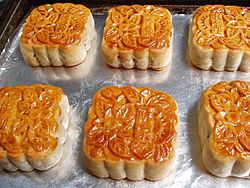 Vietnamese mooncakes fresh out of the oven. The Sino-Vietnamese characters on the cakes say "Nguyễn Family."
Vietnamese mooncakes fresh out of the oven. The Sino-Vietnamese characters on the cakes say "Nguyễn Family."
Indonesia
In Indonesia, there are hundreds of types of moon cakes, from the traditional to the modern mooncakes. The very traditional mooncake has been there ever since the Chinese and Japanese entered Indonesia, they are circular like a moon, white and rather thin. Fillings may include pork, chocolate, cheese, milk, durian, jackfruit and many other exotic fruits, however before 1998 it was only sold in small markets or villages. Now the traditional moon cake is easy to find in supermarkets and mini marts, rather than the modern mooncakes. The "modern" mooncakes finally entered Indonesia after 1998.
Japan
Mooncakes in Japan are known as geppei (月餅), a direct translation of the Chinese name. They are associated with Chinese culture and are sold all year round, mainly in Japan's Chinatowns. Azuki (red bean) paste is the most popular filling for these mooncakes, but other sorts of beans as well as chestnut are also used. Unlike some types of Chinese mooncakes, mooncakes in Japan almost never contain an egg yolk in the center.
Vietnam
In Vietnam, mooncakes are known as bánh trung thu (literally "Mid-Autumn cake"). Unlike other countries, Vietnamese mooncakes always come in pairs. Each pair consists of a baked and a snowskin. The fillings may contain a variety such as savory roasted chicken, pork, shark fin, mung beans, coconut or durian. However, the traditional ones are made of lotus seeds, sugar coated winter melon, Chinese sausage, peanut and sesame seeds.
Philippines
In the Philippines, while traditional moon cakes are available from local sources, Chinese-Filipinos have also created a variant called hopia (literally: "good cake"), and has a number of available fillings including hopiang munggo ("mung-bean hopia"), hopiang baboy ("pork hopia"), hopiang Hapon ("Japanese hopia", not related to moon cakes in Japan despite the name), and hopiang ube ("purple-yam paste hopia").
Thailand
In Thailand, mooncakes (in Thai ขนมไหว้พระจันทร์) are sold in Thai-Chinese bakeries during festival season. In Bangkok, traditional and modern moon cakes are not limited to Chinatown-Yaowarat, but also are found in stalls of large supermarkets. Durian-filled mooncakes are ones of the most popular sold, especially with one or two salted egg yolk.
See also
References
- ^ Asianweek
- ^ Taipeitimes news
- ^ Family culture
- ^ China inc
- ^ 鳳凰衛視中文台, 12 September 2008
- ^ http://blog.sina.com.tw/extrablue/article.php?pbgid=22988&entryid=159897
- ^ http://www.jingdaily.com/en/luxury/is-a-high-end-mooncake-bubble-forming-in-china/
- ^ http://www.asiatatler.com/hk/top_stories.php?id=4204
External links
Glutinous rice dishes List of rice dishes Arare • Ci fan tuan • Daifuku • Gangjeong • Injeolmi • Juk • Ketupat • Khao tom • Lo mai gai • Mochi • Nian gao • Rice pudding • Sekihan • Songpyeon • Suman • Tangyuan • Tteok • Yaksik • ZongziCakes Butter cakes 
Cheesecakes Ostkaka · SopapillaChocolate cakes Fruitcakes Layer cakes Angel cake · Dobos torte · Esterhazy torte · Hot milk cake · Kiev cake · Mille-feuille · Prinsesstårta · Prinzregententorte · Rainbow cake · Spekkoek · Kuih LapisSpit cakes Sponge cakes Angel food cake · Battenberg cake · Boston cream pie · Castella · Chiffon cake · French Fancy · Frog cake · Génoise cake · Lamington · Madeira cake · Madeleine · Mantecadas · Marble cake · Opera cake · Pandan cake · Paper wrapped cake · Red velvet cake · Rum cake · Shortcake · Spice cake · Swiss roll · Tres leches cake · Upside-down cakeYeast cakes Babka · Banana bread · Banbury cake · Chorley cake · Date and walnut loaf · Eccles cake · Flies graveyard · Rum baba · Streuselkuchen · Sweetheart cake · Welsh cakeSpecial occasions Birthday cake · Buccellato · Bûche de Noël (Christmas) · Christmas cake · Doberge cake · Groom's cake · King cake (Mardi Gras) · Lekach (Rosh Hashanah) · Marry girl cake · Mooncake (Mid-Autumn Festival) · Pan de Pascua (Christmas) · Simnel cake (Easter) · Soul cake (All Saints Day) · Stack cake (Wedding) · Stollen · Wedding cakeOthers Apple cake · Bizcocho · Bulla cake · Bundt cake · Carrot cake · Coconut cake · Coffee cake · Croquenbouche · Cupcake · Dacquoise · Erotic cake · Game cake · Gingerbread · Gugelhupf · Heavy cake · Ice cream cake · Jaffa Cakes · Lolly cake · Muffin · Pain d'épices · Parkin · Pavlova · Petit four · Punschkrapfen · Ruske Kape · Teacake · TompouceCategories:- Chinese dessert
- Cakes
- Taiwanese cuisine
- Cantonese cuisine
- Dim sum
- Vietnamese cuisine
- Autumn
- Glutinous rice dishes
- Pastry
Wikimedia Foundation. 2010.

